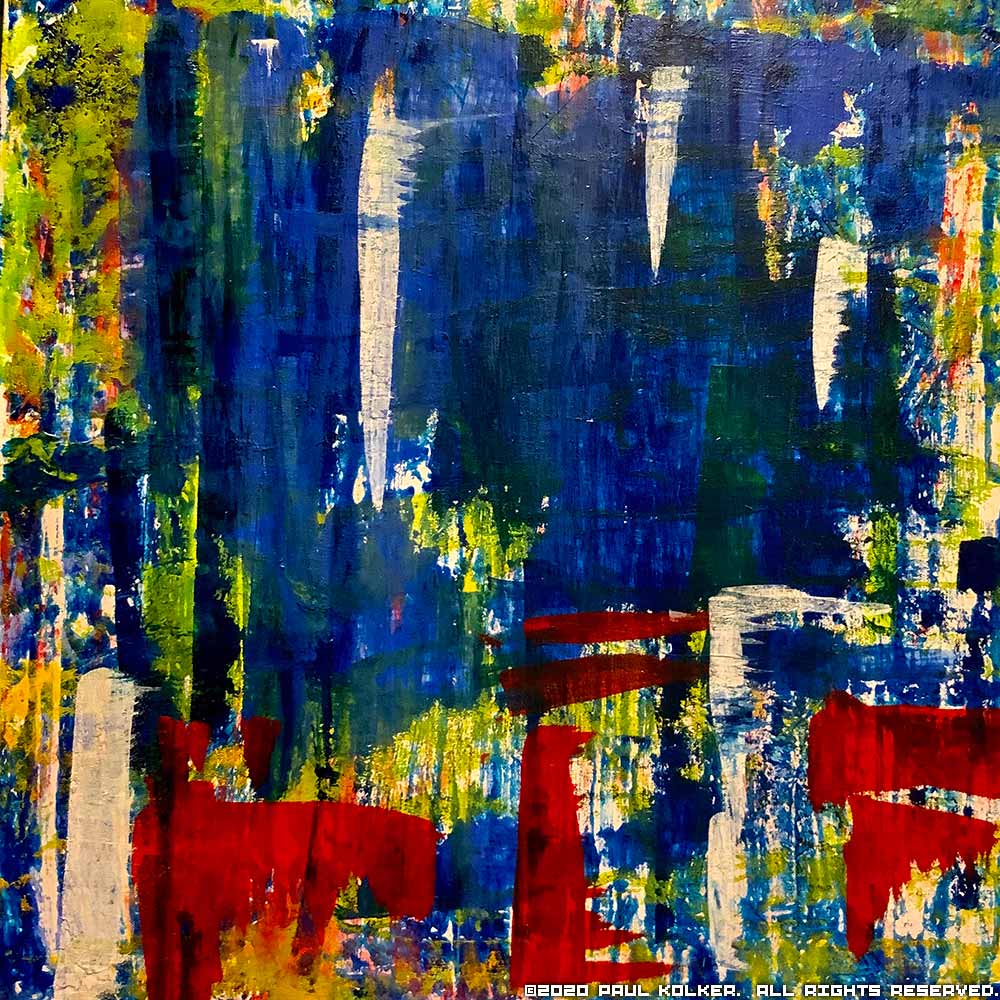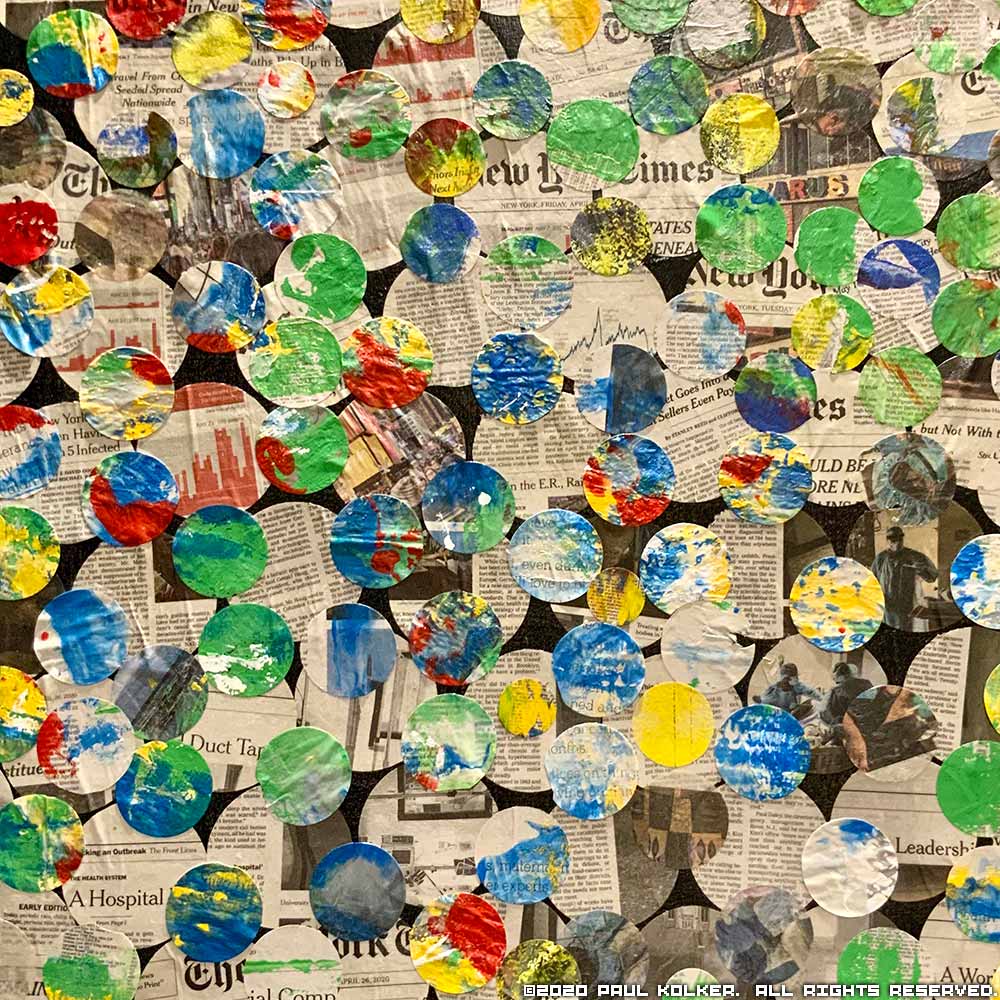
Figure 1
Paul Kolker is pleased to present his seventy-fifth solo exhibition, The Best is Yet to Be… Overpainted Tears; scheduled to open online on Thursday, September 10, 2020. The works were produced by Kolker while in COVID-19 quarantine at his Long Island studio to study and test the many procedural variables used in his making abstract decalcomania paintings, such as the one depicted above (Figure 1); and by overpainting newspaper tears laid on canvas to test the viewer’s indirect-perception, an automatic brain function which fills in visual blind spots such as those obscuring the newspaper texts used in his painting depicted below (Figure 2).

Figure 2
Kolker’s inspiration for this exhibition was first ignited in January 2020 when he revisited Robert Browning’s poem, Rabbi Ben Ezra, inviting the reader to ‘Grow old along with me: The best is yet to be,…’. Abraham ibn Ezra, the twelfth century polymathic scholar, was credited by George Sarton, in his Introduction to the History of Science: From Rabbi Ben Ezra to Roger Bacon for taking the first steps in the transition of philosophy to science; astrology to astronomy; reason to mathematical proofs; and the use of instrumentation (the astrolabe) for navigation. Ibn Ezra was a world traveler, poet and biblical scholar whose commentaries highlighted the strict rules of Hebrew grammar for the literal interpretation of scriptural writings. He created a nexus between the rationally-based scientific methods of his era and scripture, particularly in his commentary on Genesis.
Of particular interest to Kolker, who has produced light sculptures since the 1980s, were ibn Ezra’s writings about astronomy and the light emitting dots of constellations of planets and stars in the sky he may have mapped. Twelfth century philosophers had evolved into scientists using mathematics and astronomy to navigate the oceans and seas with instruments which gave them the ability to test the then unknown and abstract patterns of orbs moving in an astronomical universe of space in which over the past six decades we have just begun to travel.
Kolker curates this exhibition with the hindsight of history. He declares that as medieval philosophers had become scientists by adopting technical tools and experimenting, artists must do the same. Kolker also considers each work of art and its exhibition to be an experiment in perception in which he, and each viewer, becomes the perceptual measuring instrument which reaches far beyond the capacities of the camera, colorimeter, facial recognition computer programs and motion-orientation sensors. The human brain can also measure sensory evoked responses to promote cognition, memory, associations, orientation, appreciation… and a variety of feelings.
Serendipitously, during the curation of this exhibition, the COVID-19 pandemic struck New York City in March 2020 and Kolker’s art-making process took on another variable to study; the quarantine. In pursuit of public safety by distancing, Kolker’s Chelsea studio-gallery remains closed. Kolker now works alone in his Long Island studio. His artist assistants have been furloughed. He paints every workday, often throughout the night. His works, he says, crave the dialogical perception connecting him to those who view his works in progress. His vanilla box Chelsea gallery, only months ago open to the public, he views to be epidemiologically unsafe lacking herd immunity or acquired immunity through vaccinating sufficient populations.
Thus Kolker’s curation of the exhibition has taken on a new virtual viewing room dimension absent his gallery’s 22 feet ceilings and more than 150 linear feet to hang supersized paintings and light sculptures. Without the help of his assistants his paintings are now smaller in size; although their fractal dimension will be once again expansive when tiled into his usual multi-paneled large scale works in his new online exhibition.
Kolker’s experiment in indirect-perception studies ibn Ezra’s stars and planets as orbs and dots hidden in the daylight sky, sometimes obscured by clouds in the night sky and still hidden to naked eyes in the darkest night sky. Nearly a millennium later, they still bear a similarity to Kolker’s iconic dots set into his art works to remind us that before our wide open eyes are a multitude of ultra high-definition dots which remain hidden within the display screens of our electronic devices. Also hidden within the paintings are the overpainted and collaged tears from The New York Times, a literal subtext about the COVID-19 pandemic, for which the viewer must certainly use her indirect perception to read.
The materials and methods used to produce this exhibition are:
1. ‘Rabbi Ben Ezra, A Dramatic Monologue, 1864,’ is Robert Browning’s Victorian era preternatural dialogical-perception from which he transforms ibn Ezra’s inspirational life and ideas into a masterful work of art sung by Browning as ‘perhaps the noblest psalm in English verse.’
2. The ‘Introduction to the History of Science: From Rabbi Ben Ezra to Roger Bacon’ by George Sarton, 1934, provides an evidence based history of the polymathic ibn Ezra derived from his writings on that which is hidden from our views; and which today has become the purview of experimental psychologists, neuroscientists and others like Kolker studying indirect-perception.
3. Newspaper tears of pages from The New York Times were collected by the artist since the beginning of March 2020. Selected tears were cut into circular and linear shapes and glued on to canvas and overpainted with acrylic and pigments using Kolker’s process of abstract decalcomania described in his website.
4. Overpainting prints on canvas is a major procedural component of Kolker’s oeuvre. COVID-19 memories remain hidden within each of Kolker’s canvases prepared for this show in attribution to ibn Ezra and his starry nights… and Robert Browning’s prophetic indirect perception of perhaps ibn Ezra’s words, “The best is yet to be.”
Paul Kolker (b. 1935) is a New York based artist with doctorate degrees in medicine and law. He is Fellow, American College of Surgeons, Fellow, American College Legal Medicine and Emeritus Chief of Cardiothoracic Surgery at Northwell Glen Cove Hospital; having practiced cardiothoracic surgery on Long Island from 1969 to 2013. He also served as a founding director of MDNY, a provider owned health maintenance organization, from 1995 to 2008. In October 2001 Kolker moved his Long Island studio to his current address in the Chelsea art district so that he could produce his works and curate his exhibitions as an experiment in perception hung in his adjoining gallery, kept open to walk-in viewers. His studio and gallery have together become the laboratory for Kolker’s ‘Art as Experiment’ project. Visitors have the opportunity to see the art as it is being produced and thereby have a more expansive connection with the finished work. Those viewers also have become the measuring instruments for Kolker’s experiments about perception. While producing and curating his current show in quarantine on Long Island, Kolker says that he sorely misses the dialogical perceptions evoked by visitors and especially those by his furloughed staff; and also misses the spectacles of prior opening receptions. ‘The Best is Yet to Be… Overpainted Tears’ Is Kolker’s seventy-fifth solo exhibition; and his second to be exclusively exhibited online during the COVID-19 pandemic.
Paul Kolker: The Best is Yet to Be… Overpainted Tears will be exhibited online on Thursday, September 10, 2020 and ongoing. For more information please contact info@paulkolker.com or visit paulkolker.com
» Read The Essay Starry Nights & View The E-Book Catalogue
